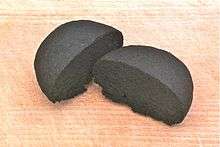Leaf protein concentrate
Leaf protein concentrate (LPC) is a concentrated form of the proteins found in the leaves of plants. It has been examined as a human or animal food source, because it is potentially the cheapest, most abundant source of available protein. Although humans can derive some protein from the direct consumption of leaves as leaf vegetables, the human digestive system would not be able to deal with the enormous bulk of leaves needed to meet dietary protein requirements with leaf vegetables alone.

Application
LPC was first suggested as a human food in the 1960s, but it has not achieved much success, despite early promise. Norman Pirie (1971, 1975), the Copley Medal winner from the UK, reviewed and emphasized the importance of its benefits,[1] which brought the subject forward. The increasing reliance on feedlot based animal rearing to satisfy human appetites for meat has increased demand for cheaper vegetable protein sources. This has recently led to renewed interest in LPC to reduce the use of human-edible vegetable protein sources in animal feed.
Leaf protein has had successful trials as a substitute for soy feed for chickens and pigs.[2]
Dietary issues
Leaf protein is a good source of amino acids, with methionine being a limiting factor.[3]
The challenges that have to be overcome using lucerne and cassava, two high density monoculture crops, include the high fiber content and other antinutritional factors, such as phytate, cyanide, and tannins.[3]
Lablab beans, moringa oleifera, tree collards and bush clover may also be used. Flavors of different species vary greatly.[2]
Methods of production
Generally, LPC is produced by pulping leaves and pressing the juice out, heating the juice to coagulate the protein, and filtering the protein out and drying it.[2]
See also
References
- "Norman Wingate Pirie Bibliography, p.16".
- Toensmeier, Eric (2016). The Carbon Farming Solution: A Global Toolkit of Perennial Crops and Regenerative Agriculture Practices for Climate Change Mitigation and Food Security. Chelsea Green Publishing. p. 181. ISBN 978-1-60358-571-2.
- Hussein, Laila; El-Fouly, Mohamed; El-Baz, F. K.; Ghanem, S. A. (1999-01-01). "Nutritional quality and the presence of anti-nutritional factors in leaf protein concentrates (LPC)". International Journal of Food Sciences and Nutrition. 50 (5): 333–343. doi:10.1080/096374899101067. ISSN 0963-7486.
Bibliography
- Pirie, N.W (1971). "Leaf protein:its agronomy, preparation, quality and use". IBP Handbook, Blackwell Scientific Publications. No 20.
- Pirie, N.W (1975). "Leaf protein: a beneficiary of tribulations". Nature. 253 (5489): 239–241. doi:10.1038/253239a0.
External links
- Leaf for Life, organization